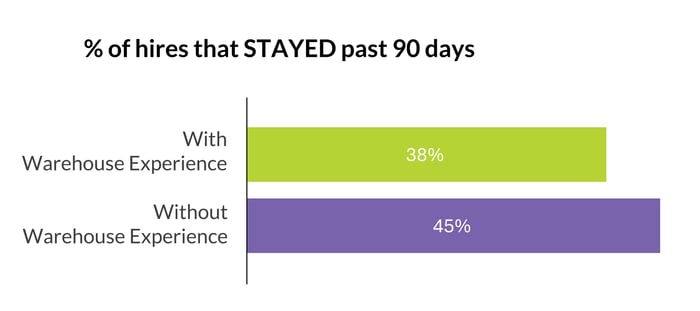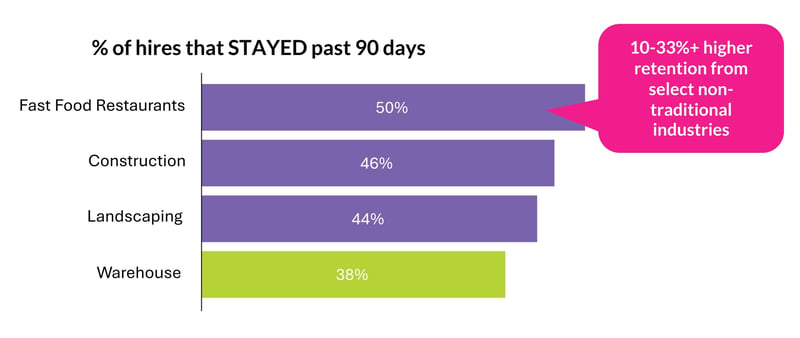Understanding Journeyfront And The Importance Of A Hiring Feedback Loop

Table Of Content
- Introducing Journeyfront
- How The Journeyfront Feedback Loop Works
- Why The Journeyfront Feedback Loop Is Critical For Successful Hiring
- How The Feedback Helps Make Hiring More Predictive
- Closing Thoughts - How The Feedback Loop Builds And Adapts Over Time
1. Introducing Journeyfront
Journeyfront has a comprehensive suite of hiring tools that work together to build and execute the ideal hiring process - meaning a hiring process that’s efficient and accurate, while meeting the unique needs and goals of an organization.
The most unique element of Journeyfront is a feedback loop built into the software that
continuously analyzes your hiring data against the post-hire outcomes you care about the most.
This serves as a data-driven mechanism for continuously improving your hiring process.
Visual: Framework for how Journeyfront analyzes pre-hire data against post-hire outcome data.

Introducing this feedback loop into hiring is the most transformative thing a company can do improve the efficiency and effectiveness of their hiring process.
It enables hiring to be data-driven and evidence-based in the same way that marketing now tracks the effectiveness of their marketing initiatives based on ROI... or finance tracks builds budgets and then tracks actual performance against those budgets.
To truly track maximize hiring's impact, a feedback loop process is needed, and Journeyfront has automated this process to make it easy and effective for organizations - especially those engaged in volume hiring.
2. How the Journeyfront Feedback Loop Works
How does Journeyfront’s feedback loop work?
-
Journeyfront tools collect and quantify all data collected on applicants - using a variety customizable hiring tools.
-
As the organization hires, performance KPIs and term data on each hire is then loaded into Journeyfront from either recurring data-imports or an integrated feed with 3rd party systems.
-
Using Journeyfront's automated feedback loop, pre-hire data is then continuously analyzed against post-hire performance and retention KPIs, identifying patterns that are then used to make evidence-based adjustments to the hiring process.
Below is an example of how pre-hire data is collected and quantified for later analysis against performance and retention.
Screening Questions

Skills Tests
Assessments
Interviews

The end to end continuous feedback loop process looks like this:
1. Journeyfront works with you to integrate or build your ideal hiring process using Journeyfront tools - administer application questions here, insert an assessment or skills test there, maybe 1-2 interview steps as well that screen for X, Y, and Z traits.
Components of the screening plan using Journeyfront tools can include the following:
- Screening questions
- Resume
- Skills Tests (Typing/Computer Skills, Language Proficiency, Cognitive Ability, Communication Skills, etc.)
- Job Simulations
- Job Fit/Behavioral Assessments
- One-way Video Interview
- Interview Guides/Scorecards
- Etc.
[Note: each of the above tools are a la carte and can be customized into the ideal screening process to meet your unique needs and goals.]
Once Journeyfront is launched, organizations begin screening/hiring candidates using the screening plan / hiring process built.
Visual: screenshot of screening plan builder in Journeyfront.
Visual: As you begin hiring, all candidates are auto-scored and ranked allowing for bulk sorting , qualifying/disqualifying, moving from stage to stage, communicating, and ultimately, decision-making.
Visual: Journeyfront tracks candidate scores collected across the process into aggregate candidate scorecards, driving faster and more effective decision-making. Scorecards are filterable by attribute and by hiring step, in addition to various other views.
2. As you hire, Journeyfront integrates your performance and retention data into Journeyfront (again, through either recurring data imports or an automated feed to your Performance Management System or Human Resource System). This identifies the trend of key hiring outcomes by hiring class. Why by hiring class? So we can determine how accurate the hiring process is and when adjustments are made, whether changes to the hiring process moved the needle in outcome areas of focus.
Visual: Turnover by hiring cohort dashboard - % of hires that stay vs. turnover at different time periods by time period hired
Visual: Performance by hiring cohort dashboard - % of hires that stay vs. turnover at different time periods by time period hired
3. As retention and performance data is collected, Journeyfront dashboards begin to populate identifying trends of what’s being measured pre-hire and what correlates with performance and retention (post-hire).
Visual: Attributes scores correlated with performance and retention dashboard
Visual: Interview question scores correlated with performance and retention dashboard
Visual: Interviewer effectiveness dashboard - shows how effectiveness interviewers are at correctly predicting which candidates will perform/stay (based on their interview scores and the candidate's post-hire performance/retention)

The above constitute a few of the many reporting and analytics dashboards available in Journeyfront.
4. Journeyfront helps your team use the data to make adjustments to the process. At first we’ll do with you, and over time, you’ll know how to do it yourself; Either way, we'll continue to assist as needed throughout the journey.
As you learn what's effective and not effective, adjustments can be made to either improve hiring efficiency/speed or hiring accuracy - or typically both outcomes at once. This is the power of continuous tracking and optimizing that the feedback loop brings. Below are a few examples of the kinds of adjustments our clients have made using this process:
Examples of small hiring adjustments:
- Find a question isn't working? Drop (or change) the question.
- Find a trait or entire hiring step that is more predictive of job success? Weight it more in the hiring scorecard and thereby, the hiring decision.
Example of medium hiring adjustments:
- Find a candidate source is delivering your best hires? Adjust marketing spend to higher ROI source accordingly.
Example of large hiring adjustments:
- Interview isn’t predicting job success, even after multiple optimizations? Remove or fully automate the interview for greater efficiency/accuracy (by leveraging Journeyfront's other automated screening tools)
3. Why The Journeyfront Feedback Loop Is Critical For Successful Hiring
The importance of this feedback loop cannot be overstated. Why?
- It allows companies and hiring teams to evaluate the impact of their hiring efforts.
- It allows companies to refine their hiring process over time into something that truly predicts candidate job success.
Let’s take each one at a time.
1. How the feedback helps monitor the impact of hiring efforts
The Journeyfront feedback loop allows companies and hiring teams to measure the impact of their hiring efforts and make evidence-based adjustments as needed. This assists companies in understanding whether the hiring activities you put candidates during the evaluation and selection phase actually lead to hiring outcomes that matter, such as new hire performance and/or retention.
The reason this capability is essential is organizations continuously make decisions related to the hiring process that are rooted in conjecture and not evidence (data).
Even smart people get this wrong.
In the 2010’s, Google infamously used brain teasers in the hiring process to evaluate and select candidates, believing that candidates who could ‘estimate the number of baseballs that fit in a 747 airplane were more likely to be successful at Google. After 10 years of leveraging this approach, they decided to put it to the test, taking the data on hires who previously scored the lowest and highest on brain teasers and comparing that to those same hires’ job performance. The result? Google found brain teasers had zero bearing (or correlation) with actual success in the job, despite having screened out thousands of candidates as if otherwise.
High volume hiring organizations like call centers or warehouses can get this wrong as well.
For example, one warehouse client for years screened candidates heavily for whether or not they had prior warehouse experience. Once they ran this data through the continuous feedback loop of Journeyfront, they found - not only was a candidate’s prior warehouse experience NOT correlated with performance or retention in the role, but candidates with specific NON-warehouse experience performed AND were retained at significantly higher rates than candidates with traditional warehouse experience. They have used these findings to improve their candidate screening process accordingly.

Another example from the call center world. Call centers routinely rely on the hiring manager interview for final hiring decisions. The assumption is that this interview is the most accurate assessment of a candidate’s ability and fit, hence the reason it's the final and often most important step in the hiring process.
When this client deployed Journeyfront’s assessment and interview guides for the phone screen and hiring manager interviews and then measured the effectiveness of each step, they found that the assessment was the most predictive element of the hiring process - i.e., more positively correlated with both new hire performance and retention than scores from both of the other hiring steps.
Visual: Client's overall interview scores from candidates correlated with candidate's performance at 60 days (post-start date)
Luckily, Journeyfront doesn’t just track whether overall steps are correlated with performance and retention, but also the sub-scores or inputs associated with each step (e.g., underlying scores on questions, traits/skills, etc. ). In this case of this client, Journeyfront dashboards enabled the company to drill in to assess the specific problem.
The problem? Of the 7 questions asked during the hiring manager interview, 4 were correlated with performance or retention, and the other 3 were not. Image shown below.
Visual: Visual showing how Journeyfront system identified interview questions that were predictive of job performance (4/7) and interview questions that were not (3/7).

By identifying which interview questions were predictive vs. not predictive of job performance, this contact center discovered that they could actually shorten their interview process by almost 50% while improving the accuracy (or effectiveness) of the interview decisions being made.
Below you will find the correlation of the hiring manager interview before and after the 3 interview questions were dropped from the interview.
The above figure is to demonstrate the power of using data to drive not only decisions being made on candidates, but changes made to the hiring process itself. What was an ineffective hiring manager interview yielding zero benefit to the organization transformed into an effective hiring step in predicting a candidate’s likely performance in the role.
The above call center in question’s results speak for themselves. Below is the new hire performance and retention of this contact center over multiple years of tracking and optimizing hiring using Journeyfront’s continuous feedback loop.
Chart: % of hires that turned over in < 90 days (based on year hired)

Chart: % of hires that with good to exception job performance (based on year hired and company tracked performance KPIs)

No hiring process is perfect. However, making evidence-based adjustments to the hiring process over time till candidate scores by hiring step correlate with job performance and retention is the key to achieving repeatable, successful outcomes.
Visual: activity effectiveness dashboard in Journeyfront showing how steps from each step in hiring process correlate with (in this case) job performance at 90 days in seat.
Note: the above illustration shows a before and after Journeyfront activity effectiveness dashboard available in Journeyfront and part of the automated feedback loop process. This chart monitors the extent to which the scores from each hiring process activity correlate with post-hire job performance. A similar view is available showing correlations with retention as well. Ultimately, Journeyfront's entire goal is to make sure that a company's hiring process is truly predicting job performance and retention. When it is, Journeyfront helps companies understand and focus on the most predictive elements. When it is not, Journeyfront helps companies either shorten the hiring process by removing non-predictive elements that aren't helping and/or replace non-predictive elements with new activities or measures until it the hiring process is predictive.
4. How The Feedback Helps Make Hiring More Predictive (Accurate)
Achieving results like the above leads us to the 2nd and most important reason the Journeyfront’s feedback loop is crucial for organizations engaged in volume hiring:
The Journeyfront feedback loop allows companies to refine their hiring process over time into something that truly predicts candidate job performance and retention.
When you remove elements from the hiring process that do NOT predict job success or retention and focus on only elements that DO predict job success and retention, you begin hiring people more likely to perform and stay.
This may seem straight-forward. However, most organizations are not doing this today. This is either because A) their hiring process has not been truly digitized (i.e., they are not collecting data across the hiring process in a way that allows for real time and ongoing analysis) or B) they have no mechanism for scalably connecting hiring data to post-hire outcomes for the purpose of identifying patterns. Journeyfront allows you to do both of the above.
Visual: high level steps to optimize the hiring process based on ongoing results/insights over time.

This brings us to the most powerful aspect of Journeyfront: Predictive Analytics.
As Journeyfront collects enough data, the system begins to identify patterns - combinations of data points from the hiring process (like traits measured) that predict new hire performance and retention.
Visual: Historical hires actual performance and retention (Y axis) vs. same outcome predicted (X axis) 
When candidates apply, the system then scans candidates in real time based on similar patterns and predicts the candidate's likely performance and retention. Predictions show up in the candidate scorecard and can be weighted into the overall score at the top right of the scorecard based on the statistical strength of the prediction.
Hiring teams are able to then drill into underlying drivers of performance and retention to see how the candidate matches those drivers (the candidate's score is shown in the blue icon with the ideal score shown as a black icon).
Visual: Candidate scorecard with predictive analytics embedded into candidate scores; shows candidate's predicted performance and retention (on 1-5 scale) in the job based on how their scores align with that of past hires that performed and stayed.
What makes Journeyfront's predictive analytics especially powerful in the context of volume hiring is that the system continues to track patterns as you hire. This means that the accuracy of predictions gets optimized over time as more data is added to the underlying data originally analyzed.
Visual: Predictive profile (i.e., predictive model) optimizations over time based on ongoing data collected; hires below are plotted by pre-hire predicted performance (x axis) against actual post-hire job performance (y axis)

5. Closing Thoughts: Why The Feedback Loop is Critical
Hiring pioneer, John Sullivan, said, "in my research, I have found that the highest impact action that a recruiting function can take is to shift to a data-driven mode." This means shifting from building and executing a hiring process that's primarily rooted in conjecture to one rooted in data (i.e., ongoing evidence for what truly predicts hiring outcomes considered most important).
This is what Journeyfront's continuous feedback loop can accomplish for organizations. It allows companies and hiring teams to evaluate the impact of their hiring efforts and ultimately create a hiring process that truly predicts job success and retention.
When you remove elements from the hiring process that do NOT predict job success or retention and focus on only elements that DO predict job success and retention, you not only begin hiring people more likely to perform and stay, you also begin to have a hiring process far more efficient than before. For more information, visit www.journeyfront.com or see your Journeyfront representative.
...
...
...
...








